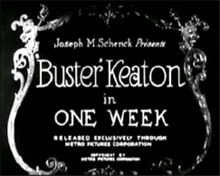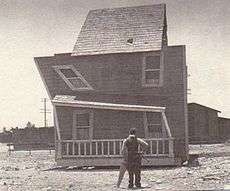One Week (1920 film)
| One Week | |
|---|---|
 | |
| Directed by |
Edward F. Cline Buster Keaton |
| Produced by | Joseph M. Schenck |
| Written by |
Edward F. Cline Buster Keaton |
| Starring |
Buster Keaton Sybil Seely Joe Roberts |
| Cinematography | Elgin Lessley |
| Edited by | Buster Keaton |
| Distributed by | Metro Pictures |
Release dates |
|
Running time | 19 minutes |
| Country | United States |
| Language |
Silent film English intertitles |
One Week is a 1920 American short comedy film starring comedian Buster Keaton, the first film to be released made by Keaton on his own; Keaton had worked with Roscoe "Fatty" Arbuckle for a number of years. The film was written and directed by Keaton and Edward F. Cline, and runs for 19 minutes. Sybil Seely co-stars. The High Sign had been filmed prior to One Week, but Keaton considered it an inferior effort to debut with, and released it the following year when he was convalescing from an injury.
Guitarist Bill Frisell released a soundtrack to the movie in 1995 on his album The High Sign/One Week.
In 2008, One Week was selected for preservation in the United States National Film Registry by the Library of Congress as being "culturally, historically, or aesthetically significant".[2]
Plot



The story involves two newlyweds, Keaton and Seely, who receive a build-it-yourself house as a wedding gift. The house can be built, supposedly, in "one week". A rejected suitor secretly re-numbers packing crates. The movie recounts Keaton's struggle to assemble the house according to this new "arrangement". The end result is depicted in the picture. As if this were not enough, Keaton finds he has built his house on the wrong site and has to move it. The movie reaches its tense climax when the house becomes stuck on railroad tracks. Keaton and Seely try to move it out the way of an oncoming train, which eventually passes on the neighboring track. As the couple look relieved, the house is immediately struck and demolished by another train coming the other way. Keaton stares at the scene, places a 'For Sale' sign with the heap (attaching the building instructions) and walks off with Seely.
The New York Times movie review said, "One Week, a Buster Keaton work, has more fun in it than most slap-stick, trick-property comedies."[3]
Cast
- Buster Keaton as the groom
- Sybil Seely as the bride
- Joe Roberts as piano mover
Production
- The film was inspired by a Ford Motor Company documentary, Home Made (1919), an educational short about prefabricated housing. Keaton saw the film and decided to parody it. One Week has many of the devices used in Home Made, including the wedding, the Model T and the use of the pages from a daily calendar to show the house being built in one week.[4]
- Many special effects, such as the house spinning around during a storm and the train collision, were filmed as they occurred and were not model work.
- The house was built on a turntable, so it would be able to spin during the violent rainstorm scene.
- The fall Keaton takes when he steps out of the bathroom and falls two stories down, is one of the few occasions he truly hurt himself making films. The impact of the fall made his arms and back swell, and his physical trainer, Al Gilmore had to put him in hot and cold showers and then apply olive oil and later horse liniment to eventually get the swelling down.[4]
- The mischievous rival is an unknown actor. Joe Roberts has a brief bit as a strong-man piano mover.
- Sybil Seely was 18 years old when she made this film. She starred in 18 movies, the last one in 1922. She died in 1984.
See also
References
- ↑ Knopf, Robert (1999). The Theater and Cinema of Buster Keaton. Princeton University Press. p. 181. ISBN 978-0-691-00442-6. Retrieved 21 October 2010.
- ↑ Littleton, Cynthia (December 30, 2008). "'Terminator' joins Film Registry". Variety.
- ↑ "The Screen", New York Times, p. 22, October 25, 1920
- 1 2 Keaton, Eleanor, and Vance, Jeffrey (2001). Buster Keaton Remembered, H.N. Abrams, p. 69.
External links
| Wikimedia Commons has media related to One Week (1920 film). |
- The short film One Week is available for free download at the Internet Archive
- One Week at the Internet Movie Database
- One Week at the TCM Movie Database
- One Week at AllMovie
- One Week at the International Buster Keaton Society